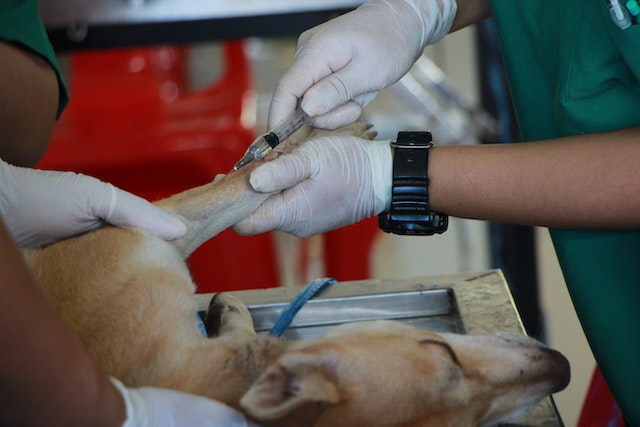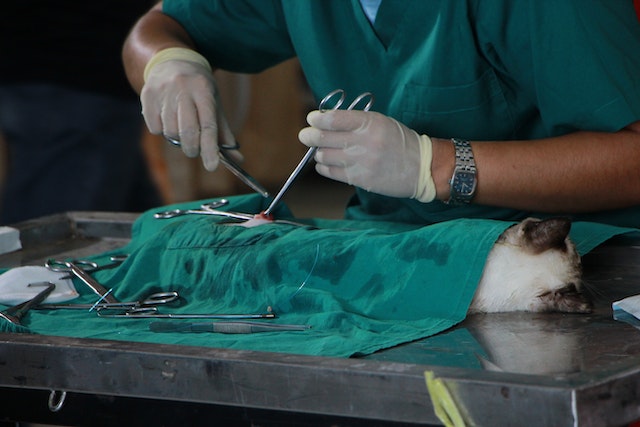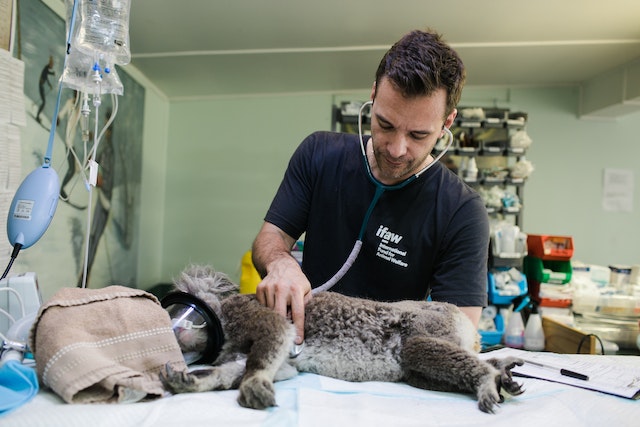Top 18 Common Pet Emergencies
Posted: 05/31/2023 | BY: Jenna Bruce | Categories: Cat , Dog , Health problems , Pet care
Having a pet is an incredible joy. But it’s also a big responsibility. Like our human loved ones, our fur babies can become seriously ill or injured in an instant. Being able to recognize the top common pet emergencies can mean the difference between life and death.

1. Bleeding
Bleeding should never be taken lightly. Anytime you see blood in your pet’s vomit or diarrhea, this is a significant cause for concern and requires immediate medical attention. Similarly, bleeding from anywhere else on the head or body may require a trip to the vet or emergency clinic. Your pet must be checked out if the bleeding lasts more than five minutes. They may require stitches to close a wound and antibiotics to stop an infection.
2. Trouble Going to the Bathroom
If your pet is straining when urinating or pooping, it can point to something more serious. Blockages in either the GI tract or the urethra can become life-threatening. Never assume the issue will resolve on its own. Take your fur baby to a vet for help ASAP.
3. Eye Injuries
Your cat or dog’s eyes are structured very differently from your own. If they should sustain an eye injury, they can easily suffer internal damage to structures close to the brain. Getting your fur baby into the vet ASAP can save them from further harm or complications.
4. Poisoning
While you do your best to make sure your home is safe for all of your family members, there are things lurking that can be deadly to pets. Many common household plants, for instance, are toxic to pets. And some things you can eat, like chocolate, grapes, and onions, can be deadly to your fur baby.
If you suspect your pet has gotten into something they shouldn’t, and if they are vomiting and/or lethargic, get them to an emergency clinic immediately.

5. GI Foreign Blockage
Just as you never know what a baby or toddler may put in their mouth, the same can be said for dogs and cats when left alone. Dogs, especially, are prone to ingesting just about anything from Legos to socks to part of your shoe. Cats are slightly more discerning and tend to eat things like tinsel and string.
In either scenario, ingesting an object they shouldn’t have can lead to an obstruction, which can be deadly. While cats and dogs of any age can and do ingest weird stuff, puppies and kittens are even more likely to.
If your fur baby is acting sick and you suspect they have ingested a foreign object, get them to the vet immediately. Symptoms of a possible blockage include vomiting, fever, and refusal to eat.
6. Gastric Torsion (Bloat)
Gastric torsion or bloat is incredibly rare in cats but quite common in certain dog breeds, such as Great Danes and German Shepherds. This is an emergency because the stomach can flip and twist, usually from a buildup of gasses or eating a big meal and then running and playing. And once the stomach flips and twists, the animal’s blood supply is cut off, which can be fatal.
Symptoms of torsion/bloat include a “drum-like_ belly, excessive drooling, an inability to eat or drink, and unproductive vomiting (meaning they try to vomit, but nothing comes up). Get your baby to the vet or ER clinic IMMEDIATELY, as they will require surgery to correct the twist and save their life.

7. Fractures
Fractures in dogs and cats are commonly caused by car accidents (either being hit by a car or being in a vehicle that has an accident.) or falling/jumping from great heights. Cats and dogs may sustain a hairline fracture (a crack in the bone) or a complete break/shattering of the bone.
Obvious signs of a bone fracture include limping, deformed/swollen-looking limbs or protruding shards of bone. Treatment protocols will depend on the type and severity of the fracture. Some may require surgery to realign bones, while others only need a simple cast or splint.
8. Seizures
If your fur baby suddenly has a seizure, they require immediate veterinary attention. Sudden staggering also requires immediate attention, as both seizures and staggering indicate an issue with the brain.
9. Pain and Anxiety
Our pets are very stoic, and sometimes it’s not obvious when they are experiencing pain. So when they ARE exhibiting signs of pain, you know something bad is going on. Anxiety is a sign of pain that many cats and dogs will show when something is wrong. A dog that is usually happy to be petted when you get home that now suddenly snaps at your hand is in great pain. A cat who suddenly doesn’t want to be touched by you has something going on. Panting, drooling, odd vocalizations… these signs indicate your pet needs to be seen ASAP to figure out what’s going on.
10. Heat Stroke
Summer can be a great time of year to enjoy the outdoors with our loved ones. But our fur babies can have difficulty handling really hot days. Animals should never be left in a hot car or even outside in your backyard for hours during extremely hot and humid days. They can quickly develop heat stroke, which can be fatal.
Signs of heat stroke include:
- Excessive panting
- Dark or bright red gums
- A dry tongue
- Staggering/seizures
- Bloody diarrhea and/or vomiting
11. Severe Vomiting/Diarrhea
When a pet vomits once or has a single bout of diarrhea, it may resolve on its own. But when a fur baby continues vomiting or has
ongoing diarrhea, you cannot wait it out and hope for the best. Animals can become severely dehydrated and even die with prolonged vomiting and diarrhea. Get them to the vet ASAP for fluids and an examination.

SAVE OR PRINT THIS INFOGRAPHIC FOR A HANDY REFERENCE GUIDE
12. Lacerations
Cats and dogs tend to play roughly with one another. They can also get into fights with other neighborhood or stray dogs and cats. The result can be one or more lacerations (cuts). Sometimes a single scratch on the nose from a paw swipe can heal fine on its own. You’ll want to clean it and watch your pet to ensure the cut doesn’t become infected.
But for deeper cuts, bite marks, or wounds near the eye, your pet should be taken to the vet ASAP for proper treatment of the wounds and possible stitches, and get an antibiotic. If they received bites or scratches from a wild animal or a stray cat or dog and your fur baby is not up to date on their rabies vaccine, they’ll also need to receive that.

13. Antifreeze Poisoning
Unfortunately, cats and dogs find the scent and taste of antifreeze intoxicating. It’s a bit like maple syrup. But though it presents sweet to your fur baby, it can be deadly if ingested, even in small amounts. Because this toxic antifreeze is so alluring to our pets, it’s imperative to keep it out of reach of your fur babies. And to always make sure your car is not leaking antifreeze in your driveway.
Signs of antifreeze poisoning include:
- Vomiting
- Excessive thirst
- Seizures
- Drunk-like behavior
14. Refusal to Drink
Healthy animals drink water consistently throughout the day. If you’ve noticed your dog or cat has not been drinking, keep a very close eye on them. You need to take them to the vet if you have not seen them drink in a 24-hour period. A refusal to drink any water in a 24-hour period points to an emergency situation.
15. Unconsciousness
This seems like an obvious one, but a pet parent may think their dog is sleeping deeply. If you cannot wake your pet, you must get them to a vet immediately. Some animals develop conditions that cause them to pass out or lose consciousness. Your vet must thoroughly evaluate them to understand why it is happening.

16. Coughing and/or Choking
Coughing can be a vague symptom of several other health conditions, including a virus, allergy, bacterial or fungal pneumonia, or even heart failure.
Seeing your cat or dog choke is terrifying for any pet parent. And even if a choking event should only last a few seconds, a lack of proper oxygen can result in a buildup of fluids in the lungs.
It’s important to know the most common choking hazards in pets so you can try and prevent them from happening in the first place.
Foreign Objects
I mentioned how dangerous it could be for a pet to ingest a foreign object. It is equally dangerous should your pup or kitty inhale a foreign object. Choking hazards include toys, balls, sticks (or part of sticks they’ve chewed off), bones, and rawhides. Really, anything that is small enough to block the windpipe can be deadly. That’s why it is important only to allow your dogs to chew on toys and bones under supervision.
Collapsing Trachea
Older, smaller breed dogs can develop a collapsing trachea. Over time with these breeds, their windpipe becomes floppy, and it can collapse when the dog sucks in air to breathe. While there is currently no cure for this condition, there are things you can do to help your dog. Strive to keep them at their ideal weight and keep them cool, so they do not pant often. Your vet may also be able to recommend cough medicine.
Infectious Disease
Kennel cough, also called infectious tracheobronchitis, is a highly contagious respiratory disease in dogs that mimics choking. Luckily, kennel cough can easily be treated with antibiotics and cough medicine.
Feline Asthma
Cats can develop asthma, just like people. When their airways constrict, they can experience labored breathing, coughing, and choking. Feline asthma is an allergic disease caused by reactions to environmental allergens, such as dust mites or pollen. While there is no cure for asthma, it can b managed successfully with medications.
Constricting Collars
This choking hazard is often overlooked, but it is common for collars to be too tight. This happens when your young dog or cat gets a growth spurt, but their collar is still sized for their younger, smaller body. If your dog frequently chokes on your walks, it may be from their pulling or because their collar is too tight.

17. Blunt Force Trauma
Blunt force trauma can happen in a variety of ways. Your child could accidentally run into your dog riding their bike. Your cat could jump from a high shelf and land on their side. Though they may get up and walk away from the incident, and while there are no external signs of injury, they could have sustained internal injuries. And usually, it can take hours for symptoms of these injuries (and an internal bleed) to show up.
If your pet has sustained any significant blunt force trauma, it is best to take them in and get them checked out before anything worse happens.
18. Allergic Reactions
Like people, our pets can develop allergic reactions to things. Common causes of these reactions are insect bites and vaccine sensitivity. Symptoms include:
- Facial swelling
- Hives
- Itchiness
- Vomiting and diarrhea
- Lethargy
- Difficulty breathing
Seek immediate veterinary care if you suspect an allergic reaction in your pet.
Are you financially prepared to handle a pet emergency?
We love our fur babies and want to ensure we do everything we can to keep them safe. But no matter what we do, sometimes accidents and illness occur. Should your pet experience an emergency, will you be able to handle those vet bills? Depending on the severity, you could be looking at a bill for thousands or even tens of thousands of dollars.
Each year, too many pet parents are faced with having to make the unimaginable decision of saying goodbye to their fur baby because they cannot afford the life-saving treatment. But scenarios like this are avoidable in many cases with a pet insurance policy.
The many Pet insurance options available now make it affordable for everyone. Some plans offer monthly payments as low as $10. And some will even reimburse you for up to 90% of the vet bills.
Take care of your pets and get peace of mind by enrolling in a pet insurance policy today.
References:
- “13 Common Pet Emergencies That Need Immediate Attention,” Retrieved from: https://suncityvet.com/13-common-pet-emergencies-need-immediate-attention/
- Molldrem, A., DVM, “Preparing for the Worst-Case Scenario,” Retrieved from: https://www.petmd.com/dog/slideshows/emergency/common-dog-pet-emergency
- “Eye Injuries In Pets: Causes, Symptoms And Treatment,” Retrieved from: https://www.vravet.com/site/blog/2022/05/16/eye-injuries-in-pets-causes-symptoms-and-treatment
- “Gastrointestinal Foreign Bodies,” Retrieved from: https://www.acvs.org/small-animal/gastrointestinal-foreign-bodies
- “Seizures and Convulsions in Dogs,” Retrieved from: https://www.petmd.com/dog/conditions/neurological/c_dg_seizures_convulsions
- “THE DANGERS OF HEAT STROKE FOR PETS,” Retrieved from: https://virginiaveterinarycenters.com/the-dangers-of-heat-stroke-for-pets/
- “Antifreeze poisoning in dogs and cats,” Retrieved from: https://hospital.vetmed.wsu.edu/2021/10/29/antifreeze-poisoning-in-dogs-and-cats/
The information contained on this blog is intended for informational and educational purposes only and should not be construed as medical advice. It is not a substitute for professional veterinary care. Always consult with your veterinarian before making any changes to your pet's health care or treatment plan.
The authors of this blog are not veterinarians and do not claim to be experts in pet health. The information provided here is based on our own experiences and research, as well as information from reputable sources. However, we cannot guarantee the accuracy or completeness of this information.
We encourage you to do your own research and consult with your veterinarian before making any decisions about your pet's health.
Previous post
Fun Activities To Do With Your DogCompare top pet insurance providers plans.
Enter your dog’s age in years and months to calculate their age equivalent to human years.
Calculate your dog’s ageEnter your cat’s age in years and months to calculate their age equivalent to human years.
Calculate your cat’s age